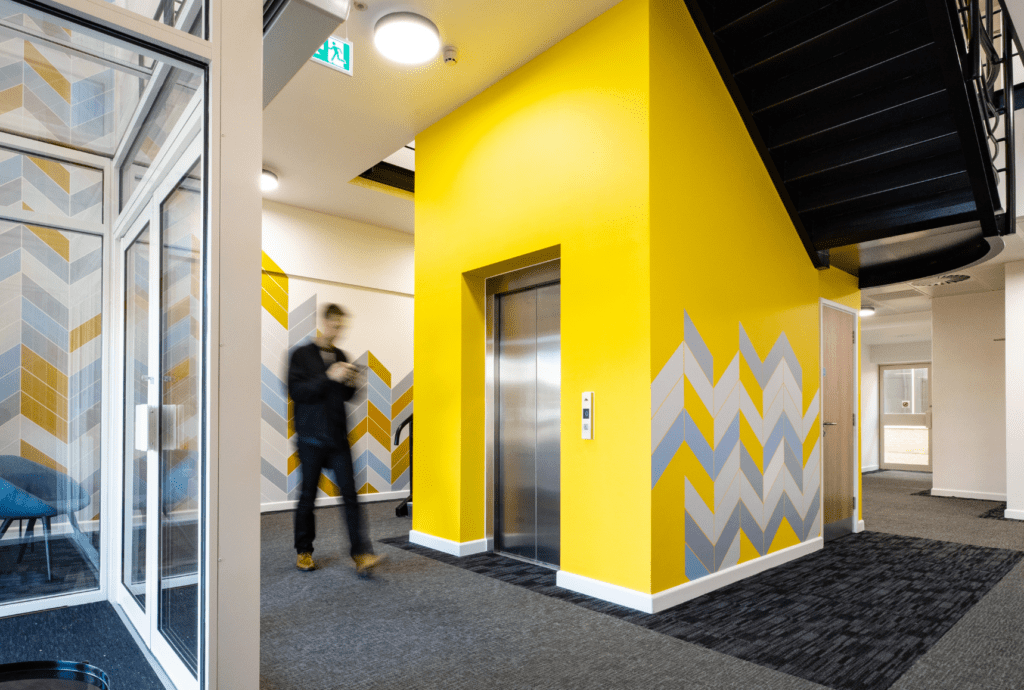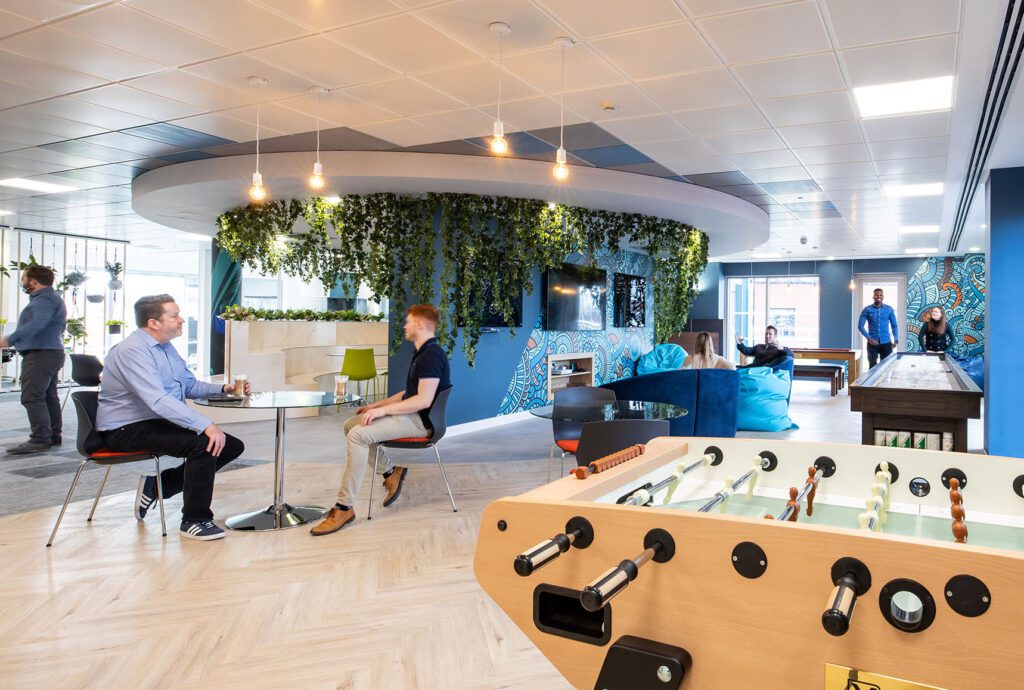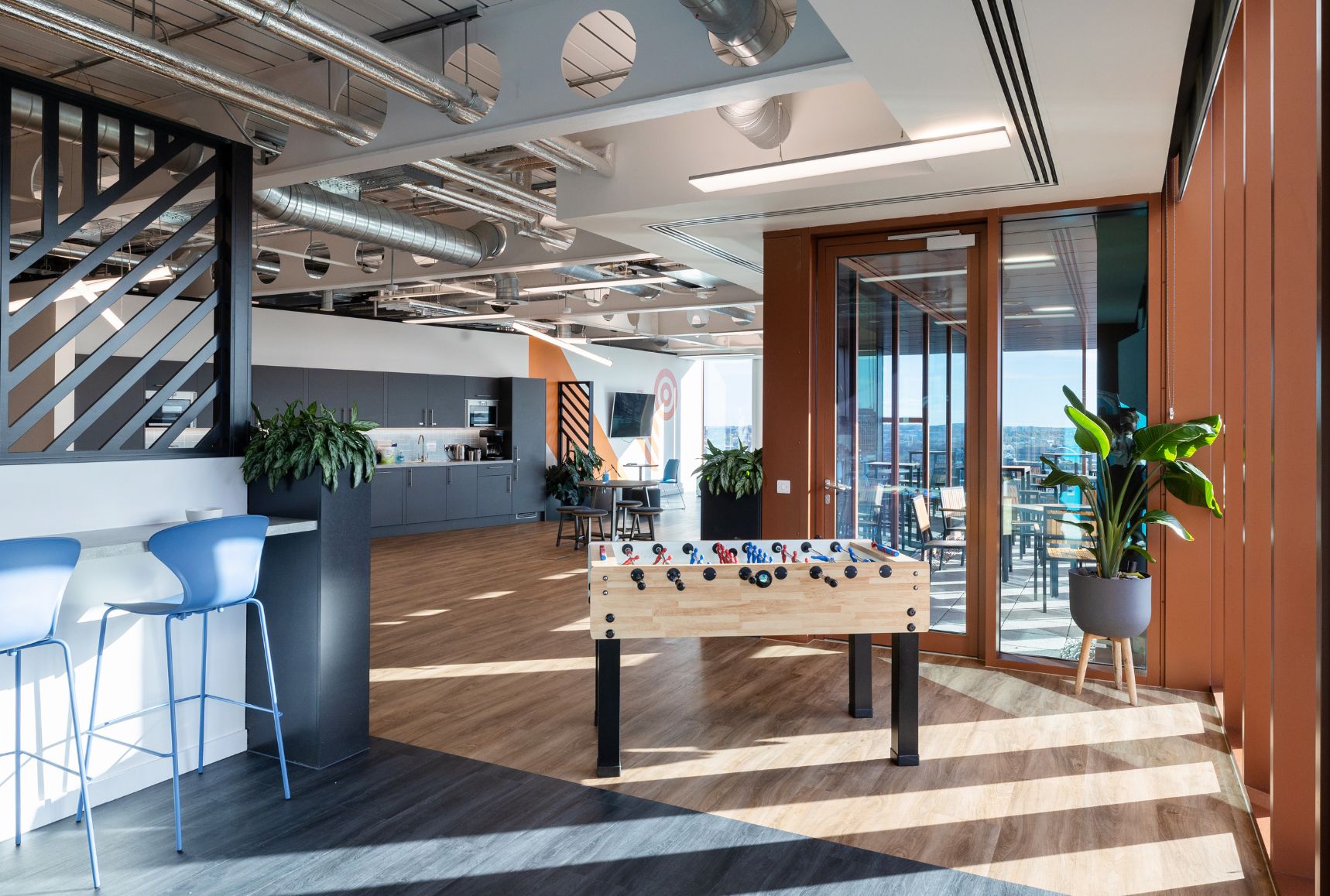What are the differences between a CAT A and CAT B fit-out?
What is an office fit-out?
An office fit-out is when a commercial space is developed to suit the needs of its owners or occupiers. This space is often an empty shell of a building. The tenant or landlord may work closely with a team of designers and developers to execute the commercial fit-out according to their vision for the workplace, making sure it’s fit for purpose and aligned with the tenant’s brand, working style and culture. This can involve renovating the space to make it more functional, modern, or energy-efficient, as well as adding features like partitions, lighting, or electrical systems. The main two types of office fit-out are CAT A and CAT B, which we’ll delve into now.
What is a CAT A fit-out?
CAT A is short for category A; it’s a fit-out project that results in a functional yet empty space – a blank canvas for interior designers to work their magic on. A typical CAT A project would be initiated on behalf of a landlord who wants a finished-yet-feature-free space to market to prospective tenants.
What is involved in a CAT A fit-out?
The main goal when undertaking a CAT A fit-out is making sure that all the necessary infrastructure and finishes are in place. This can include:
- Hot and cold water feeds
- Lighting with daylight dimming
- A Building Management System (BMS)
- Heating, ventilation and air conditioning (HVAC) systems
- Toilets and shower facilities
- Electrical wiring
- Plumbing
- Fire protection systems
- Data networks
- Security systems
What are the benefits of a CAT A fit-out?
There are several benefits to a CAT A fit-out, which may make it desirable to a landlord or tenant.
Since the CAT A fit-out provides the basic infrastructure, it leaves tenants able to allocate their budget to other areas of the fit-out process. It can also save money on bills since a typical CAT A fit-out will include the installation of energy-efficient and sustainable systems.
The flexibility given to a tenant moving into a CAT A space is another benefit. They can customise the space to align with their preferences and needs, ultimately creating a workplace which is personal to them.
When compared to other categories of fit-out, CAT A usually has a quicker completion time, allowing tenants to move into their space sooner.
How much does a CAT A fit-out cost?
Variables such as location, the age of the building, and the desired finish mean the average CAT A fit-out costs range from £50-100 per square foot. It’s always best to consult with one of our contractors to get an accurate estimate cost for your space.
What are some examples of
CAT A fit-outs?
St Stephens House, 7,592 sq ft
We created this contemporary, creative and open-plan space, which looks appealing inside and out.

See the full case study here.
Pinesgate, 30,000 sq ft
It was time to reinject some life into this Bath property to create a desirable commercial office space. We stripped the building back to its shell before carrying out a full CAT A refurbishment.

See the full case study here.
What is a CAT B fit-out?
CAT B is short for Category B. Most often a CAT B fit-out will be commissioned by a tenant who is seeking to either turn an empty space into a finished workspace environment or overhaul an existing office.
Ideally beginning with a period of workplace strategy consulting and space planning, a CAT B fit-out will be tailored around the bespoke requirements of an individual business, from the type of work carried out there to the colour of the vases in reception.
A CAT B fit-out comprises the basic infrastructure and services of a CAT A fit-out, as well as additional interior design and other comprehensive elements. Fixtures, flooring and ceiling finishes, as well as walls, doors and windows come together in a CAT B fit-out, creating a functional and aesthetically pleasing space that is ready for immediate occupation.
What is involved in a CAT B fit-out?
A CAT B fit-out provides a tenant with a tailor-made workspace. Features may include:
- Dining & social areas
- Collaborative areas with mobile tables and an auditorium
- Quiet areas, a wellness room and a soundproof podcast room
- An area dedicated to health & wellbeing such as a gym or yoga studio
- Breakout spaces such as a game room or a bar
- Fun décor items including soft furnishings
- Foliage and other natural elements
- Bespoke joinery
What are the benefits of a CAT B fit-out?
Undoubtedly, CAT B fit-outs are environments which bring out the best in their people by making them feel content at work. These spaces are customised for their tenants, providing a standout client-friendly office and helping them attract and retain talent.
A well-designed workplace can improve morale and efficiency among employees. Since a CAT B workplace is ready-to-use, all the necessary features and infrastructure are in place, removing barriers to productivity.
Similar to CAT A, these workplaces are typically energy-efficient, which not only reduces bills but also increases the property value, alongside other factors.
How much does a CAT B fit-out cost?
A CAT B fit-out turns your space into a fully functional office. Again, costs vary (there are even more variables to consider here), but typically CAT B fit-out costs range from £60-£120 per square foot. It’s always best to consult with one of our contractors to get an accurate estimate cost for your space.
What are some examples of
CAT B fit-outs?
Xledger, 13,216 sq ft
Xledger is a people-focused business that needed an office to accommodate a variety of working styles. The design honours their Scandinavian heritage, whilst nodding to their hometown of Bristol. This fit-out has a great focus on sustainability, a wellness room, and even Peloton bikes.

See the full case study here.
Granger Reis, 3,550 sq ft
Granger Reis wanted a destination workplace to encourage in-office working after so long spent working from home. We made use of a ‘broken plan’ layout to promote collaboration whilst balancing the need for privacy and fewer distractions.

See the full case study here.
Interaction’s Ultimate Guide to Office Fit-outs [PDF Download]
A comprehensive step-by-step guide to office fit-outs. Advice on decision making, budgets and finding a location. Download here.

What is the difference between a CAT A and a CAT B fit-out?
Whilst both refer to design and build projects in commercial properties, the work involved in CAT A and CAT B fit-outs does vary.
For example, CAT A fit-outs result in a blank canvas. Meanwhile, a CAT B fit-out includes all the functional features included in a CAT A space, as well as the elements needed to bring an occupant’s office to life (such as furniture and branding).
Are CAT A or CAT B fit-outs more common?
When discussing which type of office fit-out is more common, it all comes down to the client in question. CAT A fit-outs are more common with landlords looking to prepare a space so that it is usable for a tenant who can add their personal touches at their own expense. CAT B however is typically more common amongst tenants who are seeking a space tailored to their needs.
Are CAT A or CAT B fit-outs more cost-effective?
This begs an impossible question since the two are vastly different. A CAT B fit-out naturally comes at a higher upfront cost, but after completion does not require much further investment aside from general maintenance. Whilst a CAT A typically has a lower cost per square foot, it does not prepare a workplace for immediate occupancy but instead requires furnishing and styling at a later date, which will incur extra costs.
Often, spaces require a CAT A fit-out followed by a CAT B to be usable workplaces. In this scenario, it is much more cost-effective to combine the two into one large-scale delivery. For example, if the precise layout and usage of the space have been mapped out and confirmed before beginning the CAT A delivery, it ensures that utilities and other necessary infrastructure are placed in suitable locations. If treated as two separate fit-outs, things often must be removed, reconfigured or entirely restructured to function alongside this infrastructure when the second stage takes place.
From a tenant’s perspective, a CAT B fit-out may prove to be more cost-effective because all the design choices have been hand-picked by them. For a tenant moving into a CAT A space, it’s not uncommon to want to change some of the existing features, such as the floor, to align with their own requirements. This ends up costing more than it would have done to fit the desired floor in the first place. This can be avoided by landlords matching occupants to CAT A spaces at an early stage, meaning they can discuss their requirements before deciding on specifics.
Are CAT A or CAT B fit-outs more sustainable?
One is not more sustainable than the other, it is simply a case of making each as sustainable as possible. There are ways to make a CAT A fit-out more sustainable, for example by using more energy-efficient HVAC systems. On the other hand, we can also ensure that we use sustainable materials (such as FSC-certified timber) and think about circular economy principles when delivering a CAT B fit-out.
As well as being more cost-effective, it can also be more sustainable to combine CAT A and B fit-outs. Offices account for 15% of the total commercial property sector’s waste and 44% of the construction sector’s waste (which is the sector that produces the most waste). By avoiding situations where elements of design need to be replaced and wasted, the fit-out process becomes significantly more sustainable. For example, landlords are increasingly deciding to provide a monetary contribution to the tenants of their CAT A spaces, which can be put towards the installation of flooring that meets their needs, in an effort to be more sustainable and economical.
What is a Shell and Core fit-out?
A Shell and Core fit-out takes place before a CAT A and CAT B fit-out. It involves installing or updating the infrastructure of the building in question, specifically areas relating to the concrete and metal frame, such as:
- Lift shafts
- Lobbies
- Loading bays
A space completed up to the shell and core stage is not yet usable, it must undergo a CAT A, B or A Plus fit-out before it is ready for tenants to occupy. This can be misleading, since it may look completed from the outside, however the necessary infrastructure or amenities are not yet in place.

Need advice on a commercial fit-out?
Call us on 01225 485 600 and tell us about your upcoming fit-out project. Take a look at our case studies to see for yourself what we offer as an expert office fit-out company. Also, make sure you bookmark this guide in case you forget your fit-out terminology and need a refresher.
Join the Interaction community
Sign up for our newsletter to stay up-to-date with the latest insights
on the modern workplace and commercial property trends.



